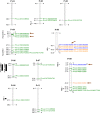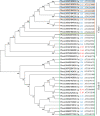Pseudomonas phaseolicola preferentially modulates genes encoding leucine-rich repeat and malectin domains in the bean landrace G2333
- PMID: 35768557
- PMCID: PMC9242968
- DOI: 10.1007/s00425-022-03943-x
Pseudomonas phaseolicola preferentially modulates genes encoding leucine-rich repeat and malectin domains in the bean landrace G2333
Abstract
Candidate resistance genes encoding malectin-like and LRR domains mapped to halo blight resistance loci throughout the common bean genome are co-expressed to fight a range of Pph races. Common bean (Phaseolus vulgaris L.) is an important crop both as a source of protein and other nutrients for human nutrition and as a nitrogen fixer that benefits sustainable agriculture. This crop is affected by halo blight disease, caused by the bacterium Pseudomonas syringae pv. phaseolicola (Pph), which can lead to 45% yield losses. Common bean resistance to Pph is conferred by six loci (Pse-1 to Pse-6) and minor-effect quantitative trait loci (QTLs); however, information is lacking on the molecular mechanisms implicated in this resistance. Here, we describe an in-depth RNA-sequencing (RNA-seq) analysis of the tolerant G2333 bean line in response to the Pph strain NPS3121. We identified 275 upregulated and 357 downregulated common bean genes in response to Pph infection. These differentially expressed genes were mapped to all 11 chromosomes of P. vulgaris. The upregulated genes were primarily components of plant immune responses and negative regulation of photosynthesis, with enrichment for leucine-rich repeat (LRRs) and/or malectin-like carbohydrate-binding domains. Interestingly, LRRs and malectin genes mapped to the same location as previously identified Pph resistance loci or QTLs. For instance, the major loci Pse-6/HB4.2 involved in broad-resistance to many Pph races co-located with induced LRR-encoding genes on Pv04. These findings indicate a coordinated modulation of genes involved in pathogen perception and signal transduction. In addition, the results further support these LRR/malectin loci as resistance genes in response to halo blight. Thus, these genes are potential targets for future genetic manipulation, enabling the introduction of resistance to Pph into elite cultivars of common bean.
Keywords: Candidate gene expression; Phaseolus vulgaris; Plant immunity; Pseudomonas syringae pv. phaseolicola; Transcriptome.
© 2022. The Author(s).
Conflict of interest statement
The authors declare that they have no financial or non-financial conflict of interest.
Figures







Similar articles
-
Dissection of Resistance Genes to Pseudomonas syringae pv. phaseolicola in UI3 Common Bean Cultivar.Int J Mol Sci. 2017 Nov 23;18(12):2503. doi: 10.3390/ijms18122503. Int J Mol Sci. 2017. PMID: 29168746 Free PMC article.
-
Pseudomonas syringae pv. phaseolicola isolated from weeds in bean crop fields.Lett Appl Microbiol. 2016 Apr;62(4):344-8. doi: 10.1111/lam.12556. Epub 2016 Mar 9. Lett Appl Microbiol. 2016. PMID: 26880144
-
The Proteomics of Resistance to Halo Blight in Common Bean.Mol Plant Microbe Interact. 2020 Sep;33(9):1161-1175. doi: 10.1094/MPMI-05-20-0112-R. Epub 2020 Jul 29. Mol Plant Microbe Interact. 2020. PMID: 32633604
-
Pseudomonas syringae pv. phaseolicola: from 'has bean' to supermodel.Mol Plant Pathol. 2011 Sep;12(7):617-27. doi: 10.1111/j.1364-3703.2010.00697.x. Epub 2011 Feb 17. Mol Plant Pathol. 2011. PMID: 21726364 Free PMC article. Review.
-
Development of molecular markers linked to disease resistance genes in common bean based on whole genome sequence.Plant Sci. 2016 Jan;242:351-357. doi: 10.1016/j.plantsci.2015.09.006. Epub 2015 Sep 9. Plant Sci. 2016. PMID: 26566851 Review.
Cited by
-
GWAS of resistance to three bacterial diseases in the Andean common bean diversity panel.Front Plant Sci. 2024 Sep 5;15:1469381. doi: 10.3389/fpls.2024.1469381. eCollection 2024. Front Plant Sci. 2024. PMID: 39301162 Free PMC article.
-
Role of a LORELEI- like gene from Phaseolus vulgaris during a mutualistic interaction with Rhizobium tropici.PLoS One. 2023 Dec 7;18(12):e0294334. doi: 10.1371/journal.pone.0294334. eCollection 2023. PLoS One. 2023. PMID: 38060483 Free PMC article.
References
-
- Asensio S, Manzanera MC, Asensio C, Singh SP. Gamete selection for resistance to common and halo bacterial blights in dry bean intergene pool populations. Crop Sci. 2006;46(1):131–135.
-
- Blair MW. Mineral biofortification strategies for food staples: the example of common bean. J Agric Food Chem. 2013;61(35):8287–8294. - PubMed
MeSH terms
Substances
LinkOut - more resources
Full Text Sources
Molecular Biology Databases

